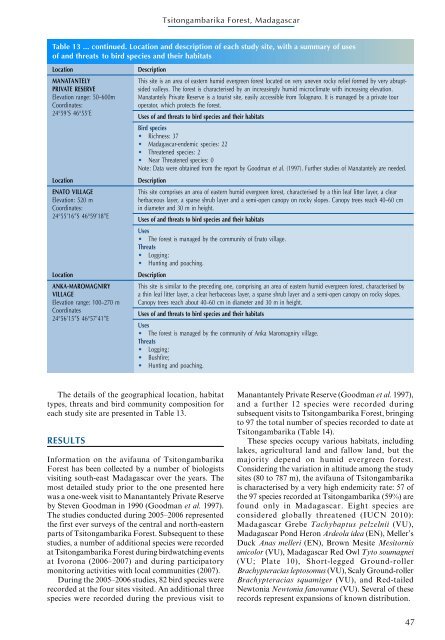TSITONGAMBARIKA FOREST, MADAGASCAR - BirdLife International
TSITONGAMBARIKA FOREST, MADAGASCAR - BirdLife International
TSITONGAMBARIKA FOREST, MADAGASCAR - BirdLife International
You also want an ePaper? Increase the reach of your titles
YUMPU automatically turns print PDFs into web optimized ePapers that Google loves.
Location<br />
MANATANTELY<br />
PRIVATE RESERVE<br />
Elevation range: 50–600m<br />
Coordinates:<br />
24°59’S 46°55’E<br />
Location<br />
ENATO VILLAGE<br />
Elevation: 520 m<br />
Coordinates:<br />
24°55’16”S 46°59’18”E<br />
Location<br />
ANKA-MAROMAGNIRY<br />
VILLAGE<br />
Elevation range: 100–270 m<br />
Coordinates<br />
24°56’15”S 46°57’41”E<br />
Tsitongambarika Forest, Madagascar<br />
Table 13 ... continued. Location and description of each study site, with a summary of uses<br />
of and threats to bird species and their habitats<br />
Description<br />
This site is an area of eastern humid evergreen forest located on very uneven rocky relief formed by very abruptsided<br />
valleys. The forest is characterised by an increasingly humid microclimate with increasing elevation.<br />
Manatantely Private Reserve is a tourist site, easily accessible from Tolagnaro. It is managed by a private tour<br />
operator, which protects the forest.<br />
Uses of and threats to bird species and their habitats<br />
Bird species<br />
• Richness: 37<br />
• Madagascar-endemic species: 22<br />
• Threatened species: 2<br />
• Near Threatened species: 0<br />
Note: Data were obtained from the report by Goodman et al. (1997). Further studies of Manatantely are needed.<br />
Description<br />
This site comprises an area of eastern humid evergreen forest, characterised by a thin leaf litter layer, a clear<br />
herbaceous layer, a sparse shrub layer and a semi-open canopy on rocky slopes. Canopy trees reach 40–60 cm<br />
in diameter and 30 m in height.<br />
Uses of and threats to bird species and their habitats<br />
Uses<br />
• The forest is managed by the community of Enato village.<br />
Threats<br />
• Logging;<br />
• Hunting and poaching.<br />
Description<br />
This site is similar to the preceding one, comprising an area of eastern humid evergreen forest, characterised by<br />
a thin leaf litter layer, a clear herbaceous layer, a sparse shrub layer and a semi-open canopy on rocky slopes.<br />
Canopy trees reach about 40–60 cm in diameter and 30 m in height.<br />
Uses of and threats to bird species and their habitats<br />
Uses<br />
• The forest is managed by the community of Anka Maromagniry village.<br />
Threats<br />
• Logging;<br />
• Bushfire;<br />
• Hunting and poaching.<br />
The details of the geographical location, habitat<br />
types, threats and bird community composition for<br />
each study site are presented in Table 13.<br />
RESULTS<br />
Information on the avifauna of Tsitongambarika<br />
Forest has been collected by a number of biologists<br />
visiting south-east Madagascar over the years. The<br />
most detailed study prior to the one presented here<br />
was a one-week visit to Manantantely Private Reserve<br />
by Steven Goodman in 1990 (Goodman et al. 1997).<br />
The studies conducted during 2005–2006 represented<br />
the first ever surveys of the central and north-eastern<br />
parts of Tsitongambarika Forest. Subsequent to these<br />
studies, a number of additional species were recorded<br />
at Tsitongambarika Forest during birdwatching events<br />
at Ivorona (2006–2007) and during participatory<br />
monitoring activities with local communities (2007).<br />
During the 2005–2006 studies, 82 bird species were<br />
recorded at the four sites visited. An additional three<br />
species were recorded during the previous visit to<br />
Manantantely Private Reserve (Goodman et al. 1997),<br />
and a further 12 species were recorded during<br />
subsequent visits to Tsitongambarika Forest, bringing<br />
to 97 the total number of species recorded to date at<br />
Tsitongambarika (Table 14).<br />
These species occupy various habitats, including<br />
lakes, agricultural land and fallow land, but the<br />
majority depend on humid evergreen forest.<br />
Considering the variation in altitude among the study<br />
sites (80 to 787 m), the avifauna of Tsitongambarika<br />
is characterised by a very high endemicity rate: 57 of<br />
the 97 species recorded at Tsitongambarika (59%) are<br />
found only in Madagascar. Eight species are<br />
considered globally threatened (IUCN 2010):<br />
Madagascar Grebe Tachybaptus pelzelnii (VU),<br />
Madagascar Pond Heron Ardeola idea (EN), Meller’s<br />
Duck Anas melleri (EN), Brown Mesite Mesitornis<br />
unicolor (VU), Madagascar Red Owl Tyto soumagnei<br />
(VU; Plate 10), Short-legged Ground-roller<br />
Brachypteracias leptosomus (VU), Scaly Ground-roller<br />
Brachypteracias squamiger (VU), and Red-tailed<br />
Newtonia Newtonia fanovanae (VU). Several of these<br />
records represent expansions of known distribution.<br />
47

















